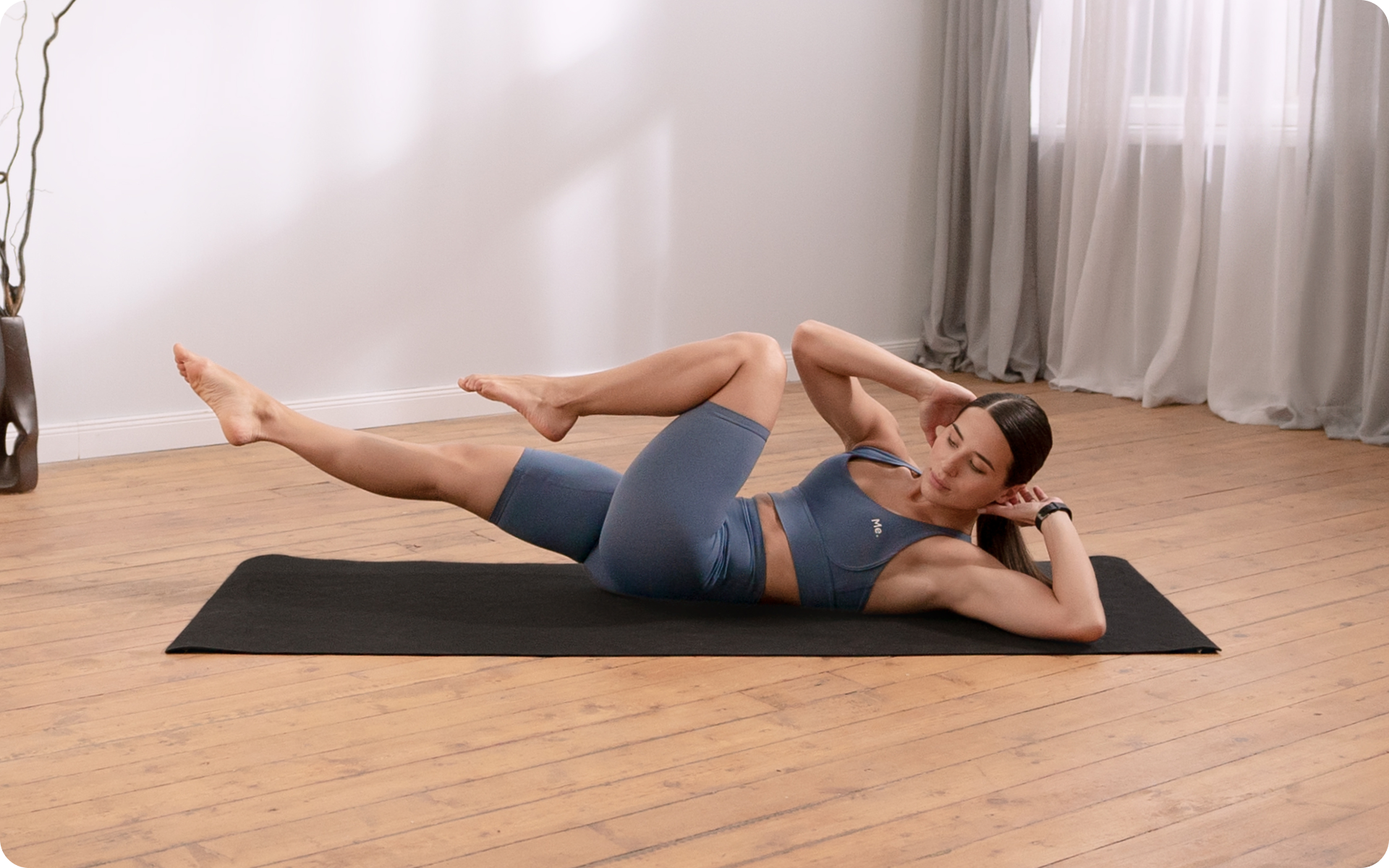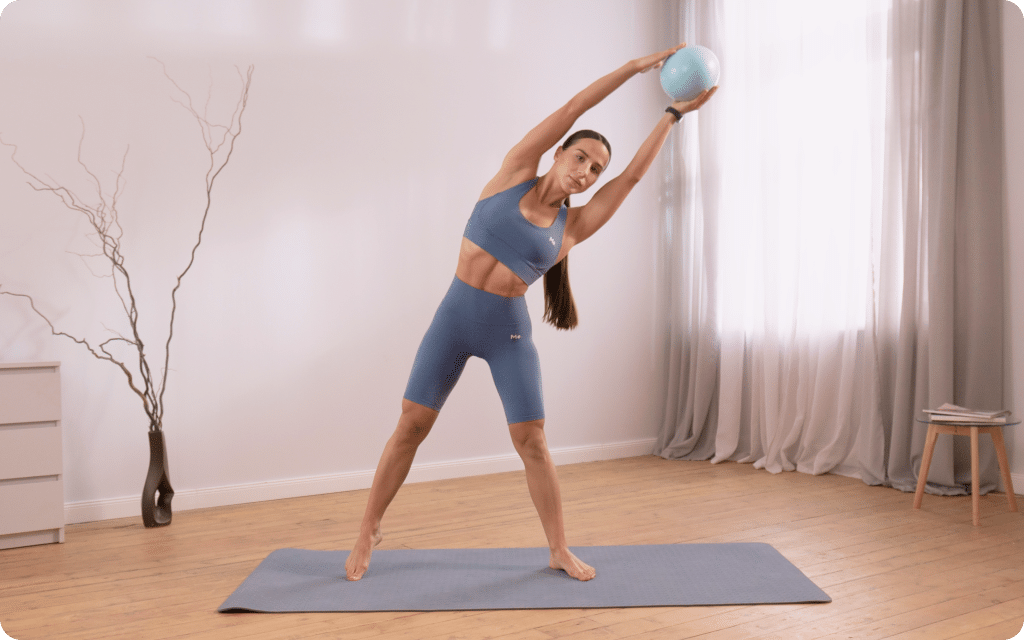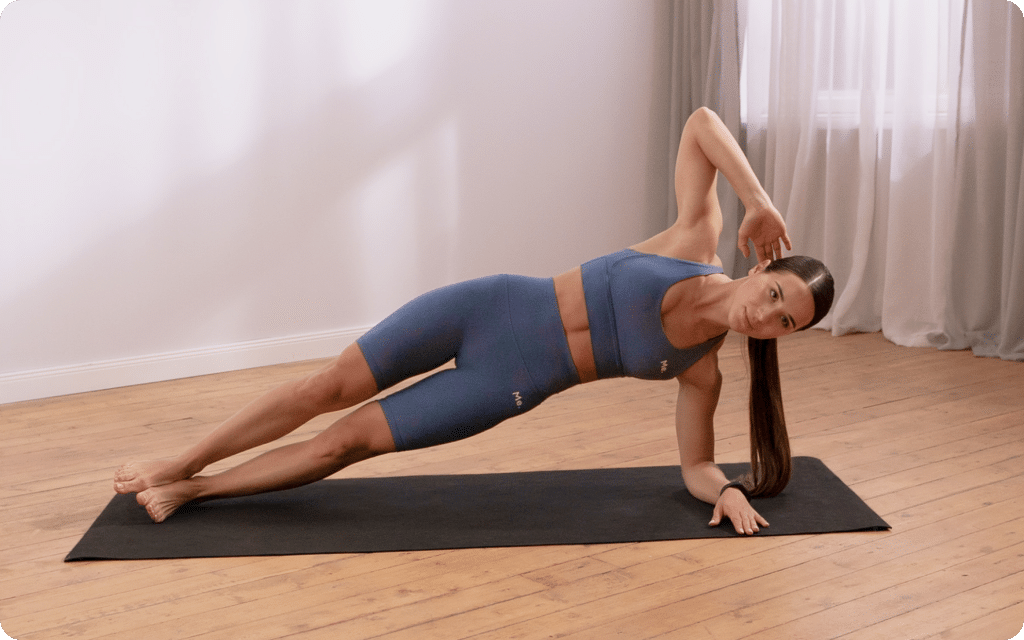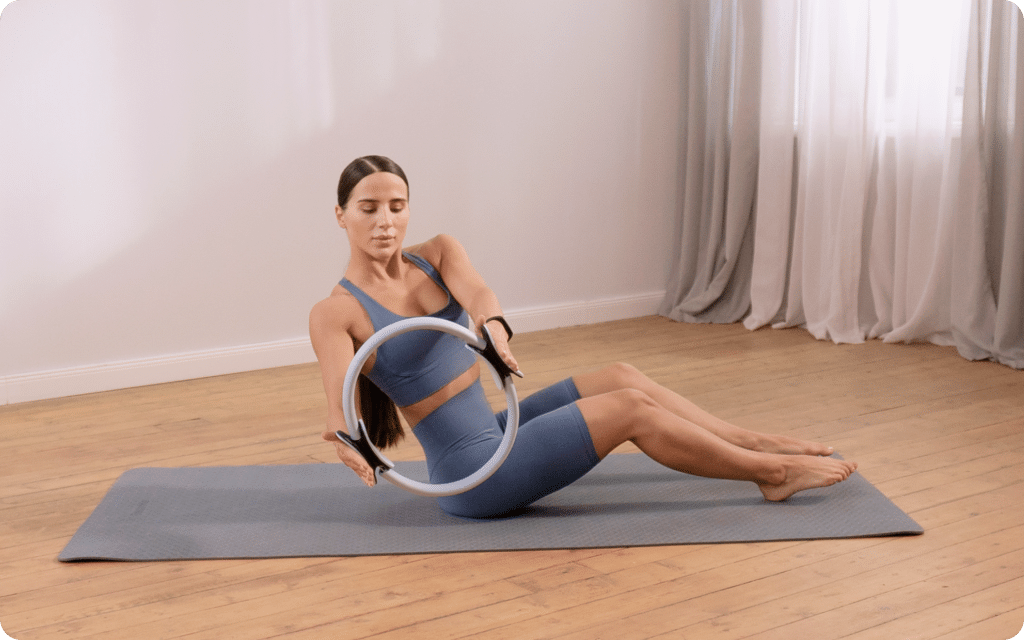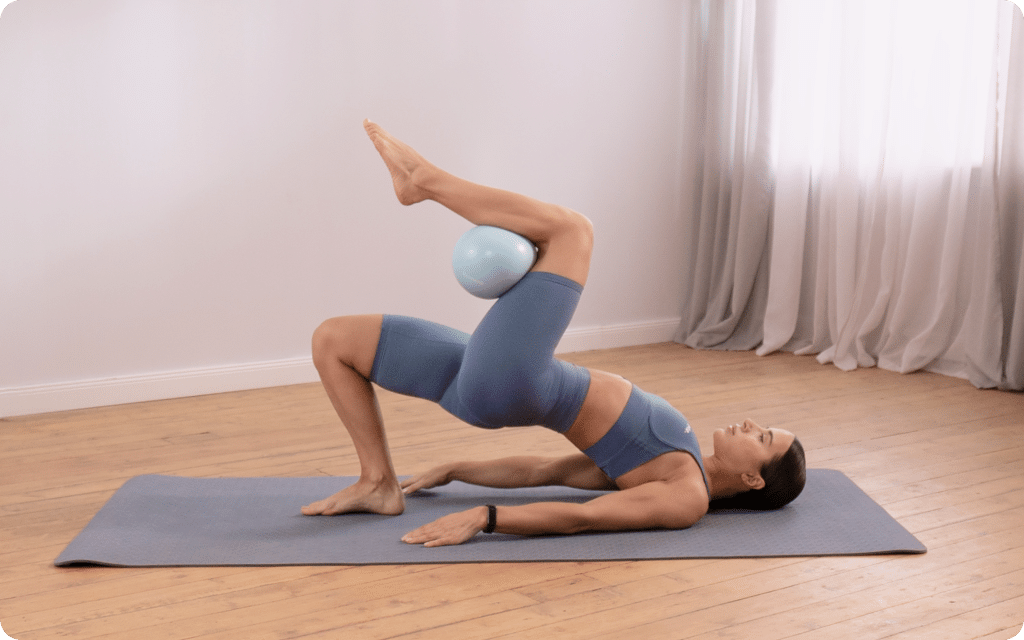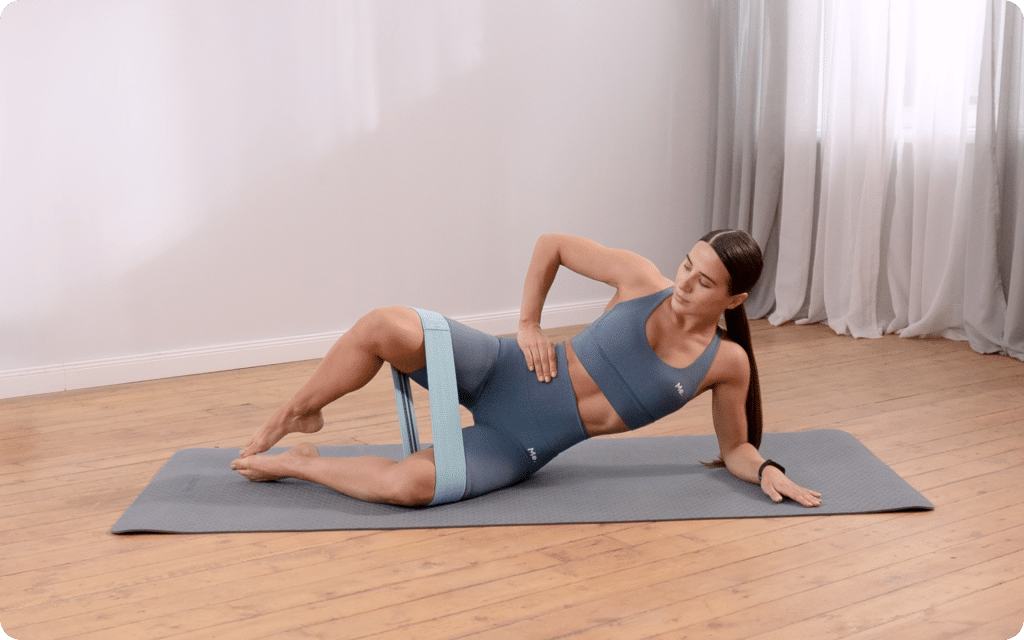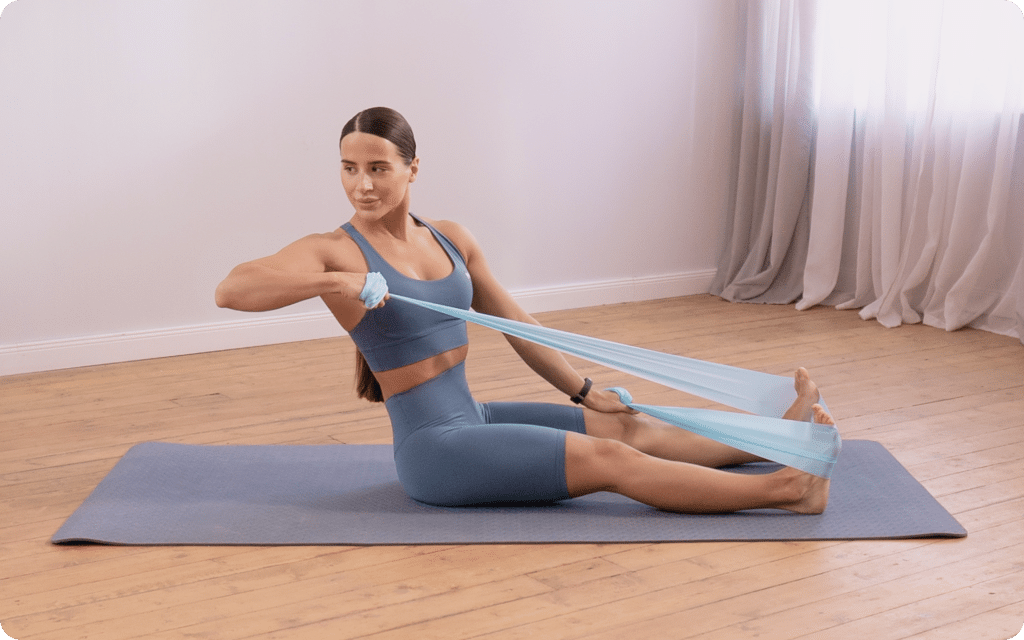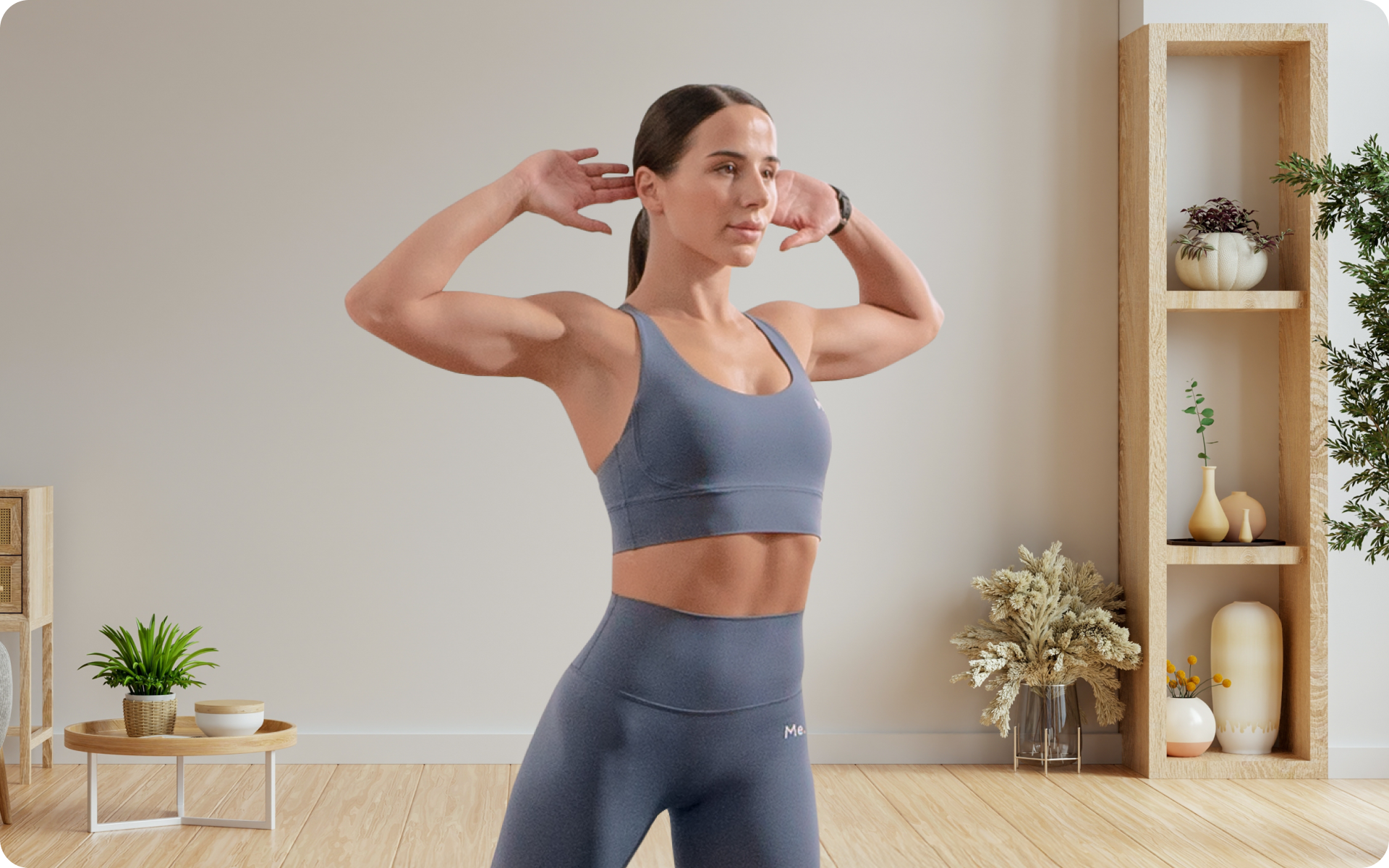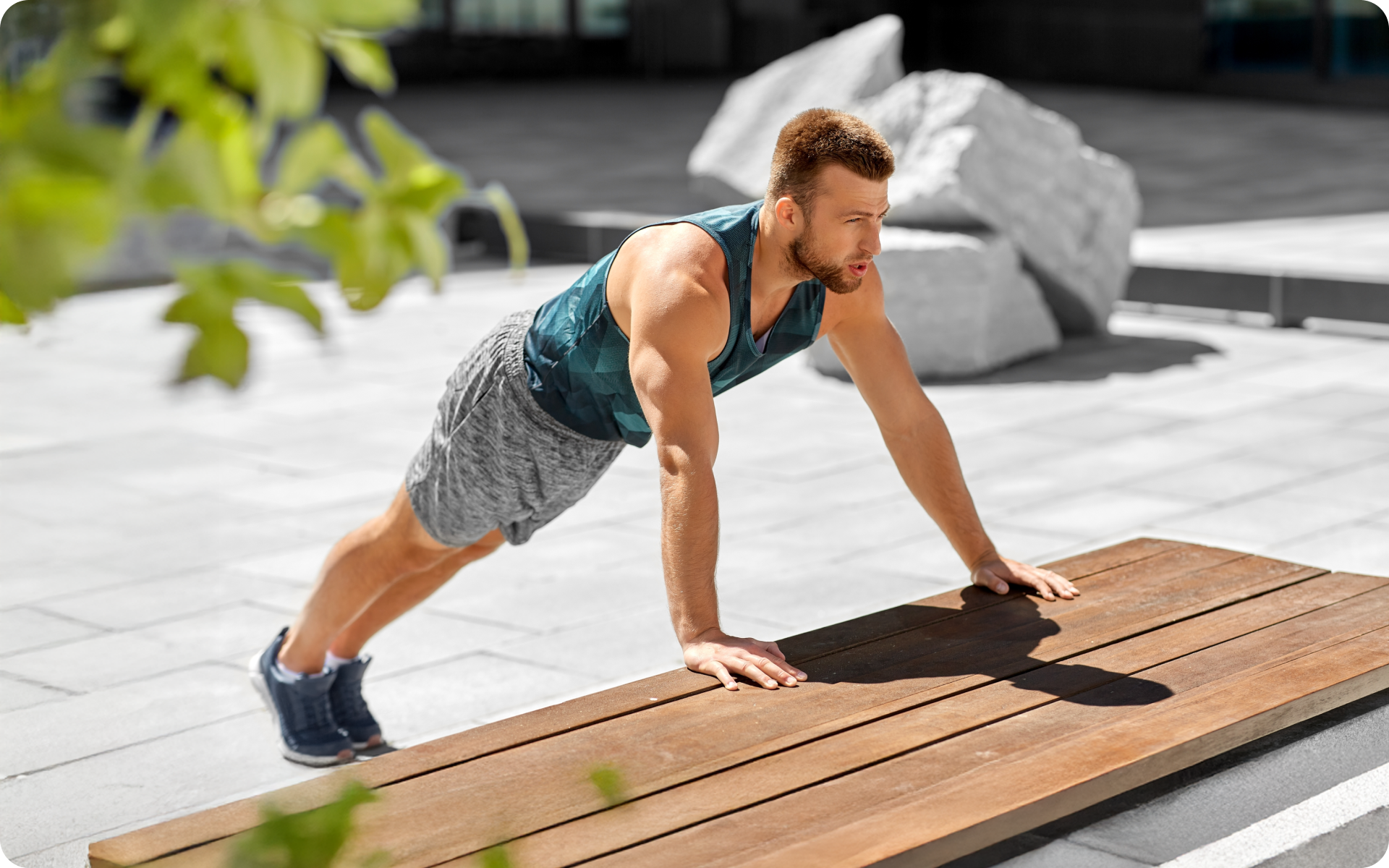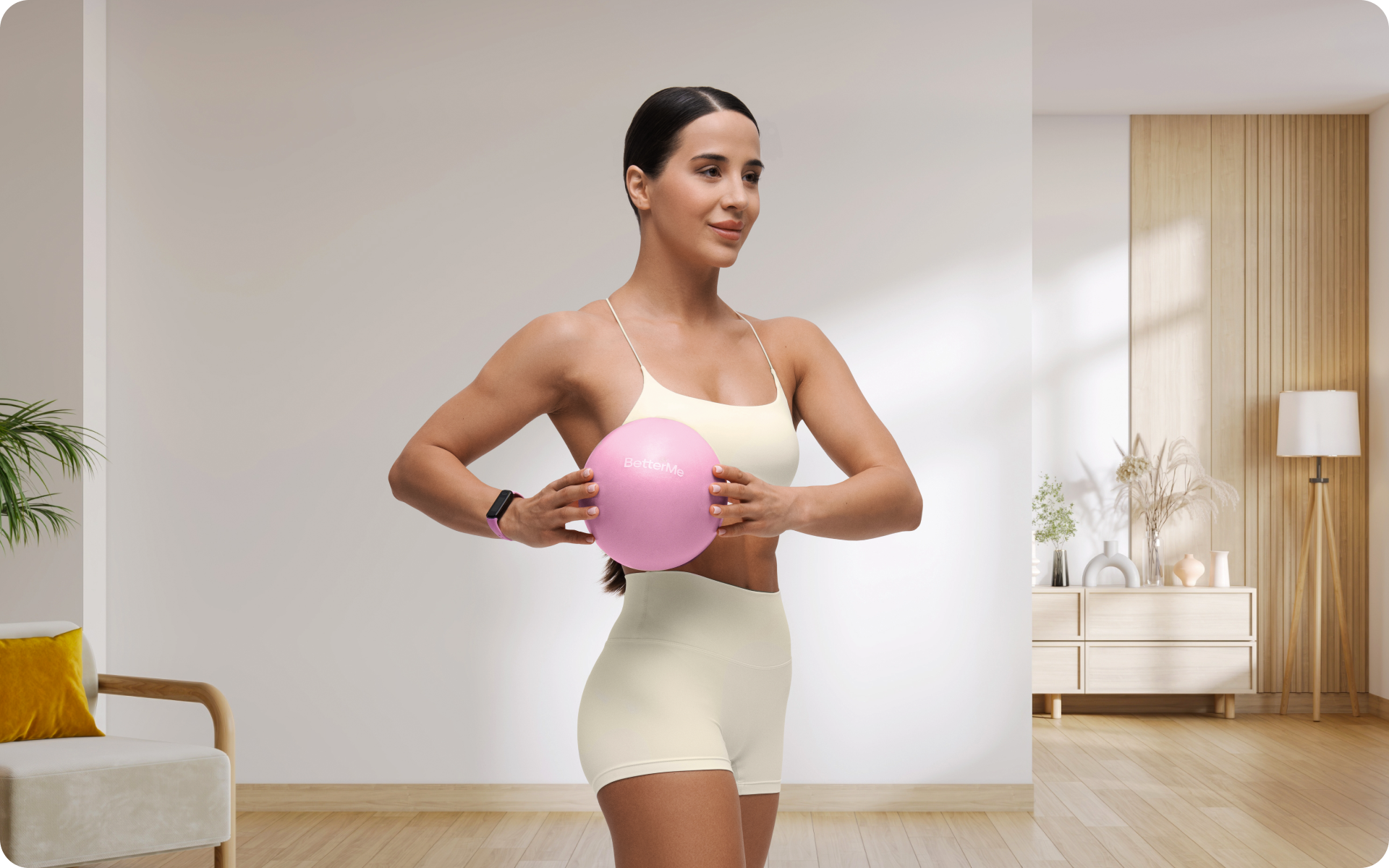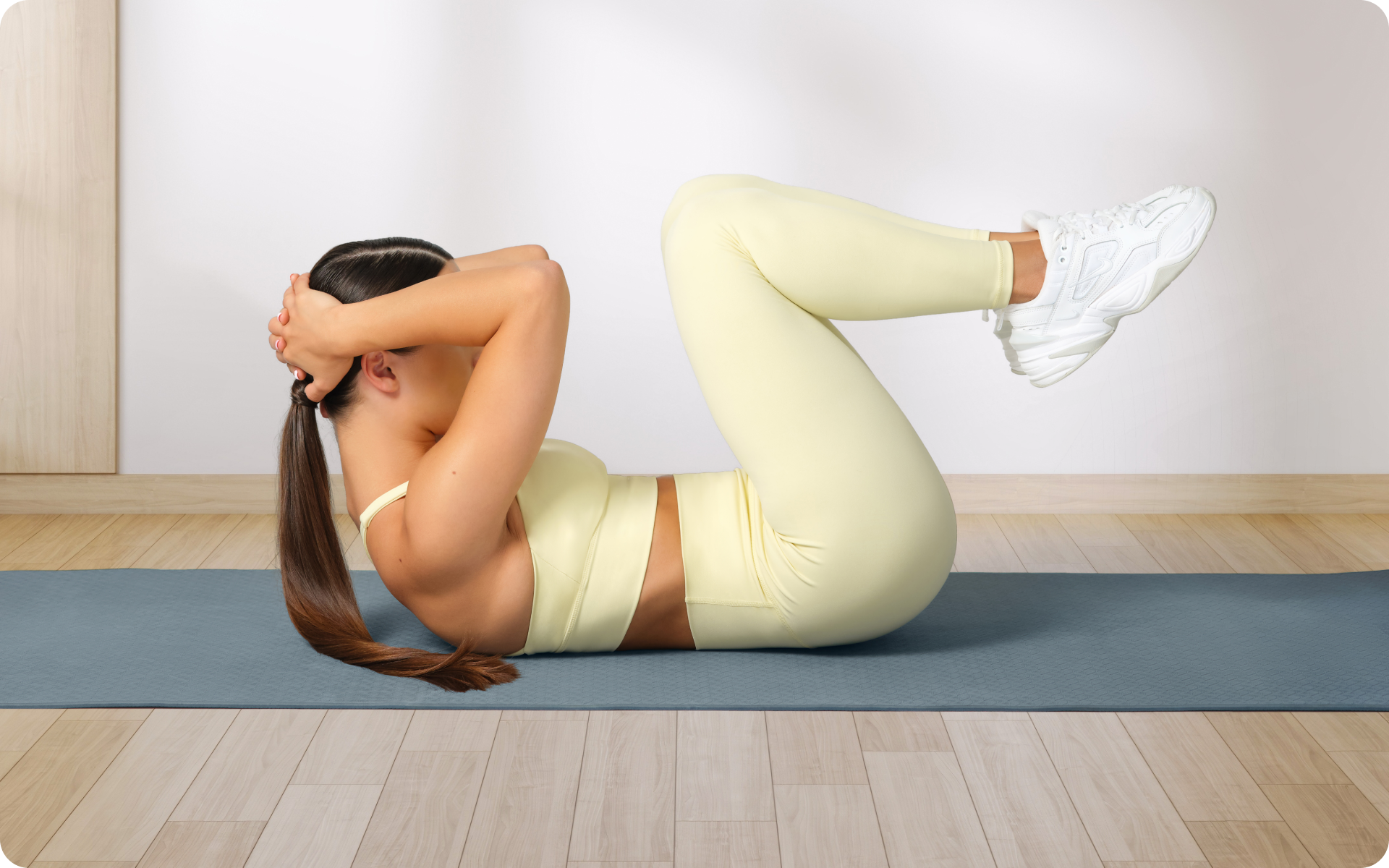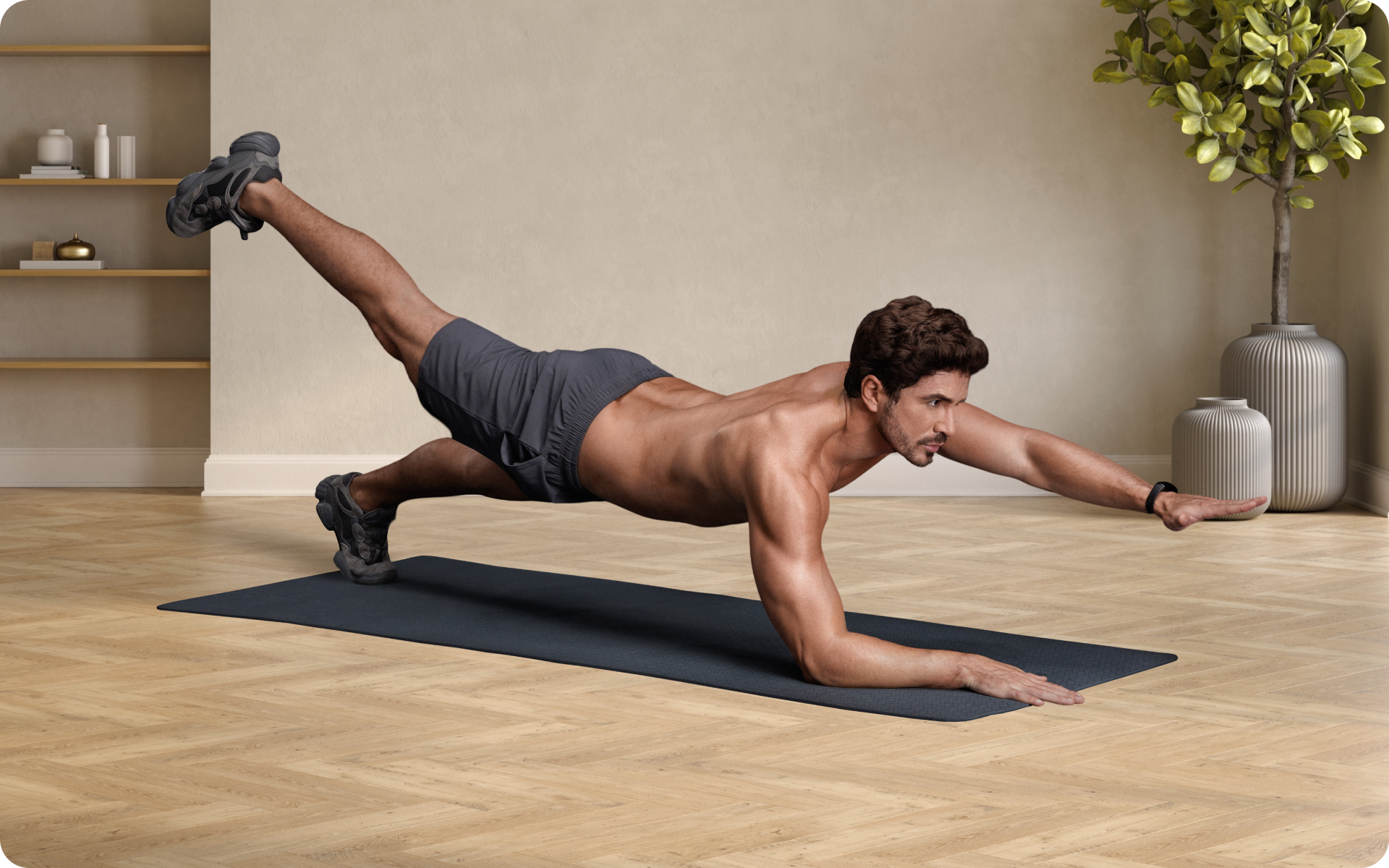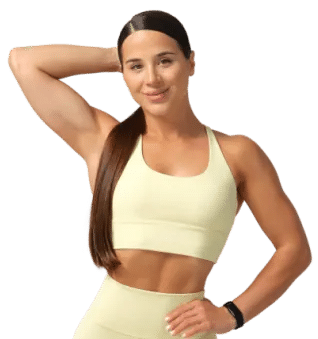Core training is about more than just working on your abs and involves strengthening the muscles that make up your entire torso. These include your abdominals, obliques, transverse abdominis, and even your lower back, hips, and pelvic muscles. Together, these muscles form your core, the central support system for almost every movement your body makes (1).
Unlike traditional ab workouts that are mainly focused on defining the front of your midsection, the aim of core workouts is to build strength and stability throughout your entire center. This is essential for better balance, posture, and injury prevention (2).
The good news? You can start building a stronger core from the comfort of your home, without any fancy equipment.
This guide will take you through easy-to-follow exercises, practical tips, and answers to common questions about core training.
What Is a Beginner-Friendly Version of Core Workouts at Home?
A beginner-friendly version of core workouts at home typically consists of bodyweight exercises that target the muscles in your abdominal, back, and pelvic areas. These exercises are often low-impact and can be modified to suit different fitness levels. To learn more about the core workouts calisthenics, check out our in-depth article on the topic.
Here’s one you can start with:
Warm-Up (5 minutes)
Start with a quick warm-up to loosen up and get your body ready for movement.
Cat-Cow Stretch (1 minute)
- Begin on all fours with your wrists directly under your shoulders and your knees under your hips.
- On an inhale, arch your back, lift your tailbone, and look up toward the ceiling (cow pose).
- On an exhale, round your spine, tuck your chin to your chest, and draw your belly button toward your spine (cat pose).
- Continue moving between these positions with each breath, flowing smoothly.
Standing Torso Twists (2 minutes)
- Stand tall with your feet shoulder-width apart and your arms outstretched to the sides at shoulder height.
- Slowly twist your torso to the right, keeping your hips facing forward.
- Return to the center, then twist to the left in the same manner.
- Continue alternating sides in a controlled motion.
High Knees (2 minutes)
- Stand tall, keeping your core braced and your arms relaxed by your sides.
- Start jogging in place, bringing one knee up to hip level with each step.
- Pump your arms as if running in order to create momentum.
- Maintain a steady pace and focus on engaging your core as you lift your knees.
Core Workout (20 minutes)
Engage all parts of your core with this series of exercises.
Plank (30 seconds to 1 minute)
- Start in a push-up position with your elbows directly under your shoulders and your body in a straight line from head to toes.
- Keep your core tight and avoid sagging your hips or raising them too high.
- Hold this position while breathing steadily. If necessary, modify by lowering your knees to the ground.
- Gradually increase the duration as you build strength.
Dead Bug (10 reps per side)
- Lie flat on your back with your arms extended toward the ceiling and your legs bent at a 90-degree angle.
- Slowly lower your right arm and left leg toward the floor while keeping your back flat against the ground.
- Return to the starting position and repeat on the opposite side.
- Focus on controlled movements and keeping your core engaged throughout.
Side Plank (20-30 seconds per side)
- Lie on your right side with your feet stacked and your right elbow under your shoulder.
- Lift your hips off the ground so your body forms a straight line from your head to your heels.
- Hold this position while keeping your core tight and breathing steadily.
- Switch sides and repeat. Modify by placing your bottom knee on the ground for support if needed.
Oblique Twists (15 reps per side)
- Sit on the floor with your knees bent and your feet slightly off the ground.
- Lean back slightly and clasp your hands together or hold a small weight if you want to add resistance.
- Rotate your torso to the right, bringing your hands toward the floor on that side.
- Return to the center and twist to the left. Continue alternating sides.
Bird-Dog (10 reps per side)
- Start on all fours with your wrists under your shoulders and your knees under your hips.
- Extend your right arm straight in front of you while also lifting your left leg straight back.
- Hold for a moment, then return to the starting position.
- Repeat on the opposite side, focusing on keeping your hips level and your movements controlled.
Glute Bridge (10-15 reps)
- Lie on your back with your knees bent, your feet flat on the ground, and your arms at your sides.
- Push through your heels to lift your hips toward the ceiling, squeezing your glutes at the top.
- Slowly lower back down to the starting position.
- Keep your core engaged throughout the movement.
Whether you’re a workout beast or just a beginner making your first foray into the world of fitness and dieting – BetterMe has a lot to offer to both newbies and experts! Install the app and experience the versatility first-hand!
Cool-Down (5 minutes)
Finish your workout with stretches to relax and lengthen your muscles.
Child’s Pose (1 minute)
- Kneel on the floor and sit back on your heels.
- Stretch your arms forward as you lower your chest toward the floor.
- Rest your forehead on the ground and breathe deeply.
Seated Forward Fold (1-2 minutes)
- Sit with your legs extended straight in front of you.
- Hinge at your hips to fold forward, reaching for your toes or your shins.
- Hold the stretch and relax into it, focusing on your breathing.
Figure-4 Stretch (1 minute per side)
- Lie on your back with your knees bent and your feet flat on the floor.
- Cross your right ankle over your left thigh, creating a “4” shape.
- Reach through your legs and pull your left thigh toward your chest, feeling the stretch in your right hip.
- Switch sides and repeat.
Read more: 7 Core Pilates Ball Exercises For Your Next Workout
How Can I Train My Core at Home?
The process of strengthening your core involves consistent activation and exercise of the muscles in the midsection of your body. These muscles work together to support your spine, stabilize your movements, and transfer force between your upper and lower body. Our previous post goes into great detail about the standing core workouts.
Your core is made up of several muscle groups (1), including:
- The rectus abdominis (commonly associated with six-pack abs).
- The transverse abdominis, which is a deep, stabilizing muscle that wraps around your abdomen like a corset.
- The internal and external obliques, which help rotate and bend the torso.
- The muscles of your lower back, such as the erector spinae, which provide spinal support.
- The pelvic floor muscles and hip stabilizers, which contribute to overall core stability.
When you perform core-focused exercises, you challenge these muscles to hold the spine and pelvis in a safe, stable position. Over time, this repeated activation triggers several physiological responses that lead to strength and stability gains. Here’s how it happens:
- Muscle Activation and Overload: Core training involves challenging your muscles with bodyweight exercises such as planks, bridges, or bird-dogs. These exercises create resistance, which forces your muscles to adapt. The concept is known as “progressive overload”. By gradually increasing the difficulty or duration of an exercise, you encourage the muscles to grow stronger (3).
- Neuromuscular Adaptations: Your nervous system plays a key role in core training. When you start working on core stability, you teach your brain and body to communicate more efficiently. This improves how your muscles fire, particularly in coordinated movements. Think of it as “training your brain” to stabilize your core better over time (4).
- Muscle Hypertrophy: While not the primary goal for many core workouts, some exercises can lead to muscle growth (hypertrophy). Isometric holds such as planks build endurance, while dynamic movements like crunches or Russian twists stimulate small amounts of muscle growth when done consistently (5).
- Improved Intramuscular Coordination: Core exercises teach your muscles to work together. For example, in a plank, your transverse abdominis, rectus abdominis, obliques, glutes, and lower back muscles engage simultaneously. This coordination enhances the effectiveness and efficiency of your movements (6).
How to Train Effectively at Home
Strengthening your core doesn’t require fancy gym equipment. You can use simple bodyweight exercises that target all aspects of your midsection. Here’s what you need to keep in mind:
- Focus on Stability Over Repetition: The best core exercises don’t just involve endless sit-ups. Movements that challenge your stability, such as planks or side planks, are more functional and impactful for your daily life (7).
- Engage Your Entire Core: Avoid isolating just the rectus abdominis. Exercises such as bird-dogs or dead bugs work your entire core, including the deeper stabilizing muscles.
- Prioritize Proper Form: Core exercises are about quality, not quantity. Holding a plank with poor form (with sagging hips or excessive spinal arch) is less effective and can increase your risk of injury (8). You must focus on maintaining control and alignment.
- Progress Gradually: Start with beginner exercises and increase the intensity by extending duration, adding resistance (like using a water-filled backpack), or moving to advanced versions (such as transitioning from kneeling to full planks).
- Consistency is Key: As with any other muscle group, your core requires regular, repeated efforts to see results.
What Are the Big 3 Core Exercises to Do at Home?
When it comes to training your core at home, the hollow body crunch, side plank, and knee raises stand out as highly effective exercises. These movements prioritize the activation of specific core muscles, offering a balance of strength, endurance, and improved muscle control.
1. Hollow Body Crunch
The hollow body crunch is a powerful isometric exercise targeting the rectus abdominis (your “six-pack” muscles) and deep stabilizers such as the transverse abdominis. It’s a great way to build core endurance, but it can be challenging for beginners due to the coordination that is required.
Steps to Perform:
- Lie on your back with your legs extended and your arms overhead.
- Press your lower back firmly against the floor. This ensures your core is fully engaged.
- Lift your legs off the ground about 6-12 inches while simultaneously lifting your shoulders and arms slightly.
- Keep your body in a slightly curved “hollow” position, with your core braced and your lower back in contact with the floor.
- Hold this position for 10-20 seconds (or longer if you’re able), then lower down with control.
Beginners’ Tip:
If this is too intense, try bending your knees at a 90-degree angle or lowering your arms to your sides for extra support. Focus on keeping your lower back pressed into the floor.
2. Side Plank
The side plank primarily targets your obliques (the muscles on the sides of your torso) while also engaging your glutes and shoulders for stabilization. It’s an exceptional exercise for core stability and spinal support. The challenge lies in maintaining proper alignment.
Steps to Perform:
- Lie on your right side with your legs extended and stacked on top of each other.
- Place your right elbow directly under your shoulder, and keep your forearm flat on the ground.
- Lift your hips off the floor until your body forms a straight line from head to feet.
- Keep your neck neutral and core braced. Hold the position for 20-30 seconds.
- Lower back down with control and switch to the left side.
Beginners’ Tip:
If holding a full side plank is too difficult, bend your knees and perform the plank with your knees resting on the floor. This will reduce the load while still engaging your obliques and core.
3. Knee Raises
Knee raises are a dynamic exercise that effectively targets the lower portion of the rectus abdominis, an area often considered tricky to train. As this movement involves controlled motion, it helps improve both strength and mobility in your core and hips.
Steps to Perform:
- Sit on the edge of a sturdy chair, bench, or even on the floor with your legs extended and your hands gripping the sides for support.
- Brace your core and lean back slightly, keeping your back straight.
- Slowly lift both knees toward your chest while avoiding any jerking or swinging.
- Lower your legs back down with control without allowing your feet to touch the ground.
- Repeat for 10-15 slow, controlled repetitions.
Beginners’ Tip:
If raising both knees is too demanding, start with single-leg knee raises. Lift one knee at a time while keeping the other leg planted on the ground for more stability.
For more easy core workouts, read one of our earlier articles..
How Often Should You Do Core Workouts at Home?
For optimal results, you should aim to train your core 3 to 5 times per week. This frequency strikes a balance between providing enough stimulus for muscle adaptation and allowing adequate recovery time.
Beginners may start with 2 to 3 sessions a week and gradually increase the frequency as their endurance and strength improve.
As with all other muscle groups, core muscles need time to repair and grow stronger after exercise. Overtraining can lead to fatigue, reduce the quality of your workouts, and increase the risk of injury (9).
When creating a schedule, consider the intensity of your workouts. Short, high-intensity core sessions may require more recovery, while moderate, controlled exercises can be done more frequently. Integrating core work as part of a full-body routine can also help avoid overworking the same muscle groups.
Read more: 7-Day Bed Pilates Challenge for Beginners
How Long Until You See Results from At-Home Core Workouts?
The timeline for visible and functional results will depend on various factors such as consistency, exercise intensity, baseline fitness level, and nutrition.
You’ll typically start to feel stronger and more stable in your movements after 2 to 4 weeks of regular training. For noticeable physical changes, such as improved muscle definition, it can take 8 to 12 weeks, assuming you’re maintaining a balanced diet and managing overall body fat levels (10).
Reasons why BetterMe is a safe bet: a wide range of calorie-blasting workouts, finger-licking recipes, 24/7 support, challenges that’ll keep you on your best game, and that just scratches the surface! Start using our app and watch the magic happen.
What’s the Fastest Way to Strengthen Your Core at Home?
The fastest way to develop core strength involves focusing on efficiency and consistency in your training. Here’s how you can maximize your progress:
- Progressively Overload Your Core: Once an exercise feels easy, increase the difficulty by adding variations (e.g. transitioning from a standard plank to a plank with shoulder taps) or extending duration.
- Engage Your Core Daily: This doesn’t mean doing intense workouts every day. Mixing lower-intensity activities such as posture correction and balance drills with your primary core workouts can strengthen your core without overtraining.
- Develop Full-Body Stability: Strengthening surrounding muscle groups, such as the glutes and lower back, enhances overall core function.
The key is consistency. A well-executed 15-20 minute session outperforms sporadic, lengthy workouts when done regularly.
Rushing through exercises sacrifices technique and reduces impact. Focus on controlled, precise movements to engage your muscles fully.
Can You Build Strong Abs with Just Core Workouts at Home?
Yes, you can build strong abs through core workouts at home. However, it’s essential to distinguish muscle strength from muscle visibility. Strengthening your core improves posture, balance, and functional fitness. Exercises such as those outlined previously effectively target your rectus abdominis, obliques, and deeper stabilizing muscles.
Visible “six-pack” abs are heavily influenced by your body fat levels. Even with strong core muscles, high body fat can obscure definition. Achieving visibility often requires a combination of:
- Fat-Loss Nutrition: Consuming a caloric deficit to reduce overall body fat (11).
- Cardiovascular Exercise: Supporting fat loss and promoting overall health (12).
- Strength Training: Building lean muscle tissue, including core muscles (13).
To engage your core, you need to focus on tightening the muscles around your torso as if bracing for a punch. You can practice this during exercises or daily activities such as standing and walking. Start by lying down, drawing your belly button slightly toward your spine, and maintaining a steady breath. Over time, this connection becomes more natural and helps improve stability and control. In addition, practicing diaphragmatic breathing can be an incredible tool for activating your core. Take a deep breath in through your chest and then exhale through your stomach. As you exhale, you will tighten your core. Now every exhale breath will act as a way to tighten the core even further. This tip can be used when planking and will allow you to breathe better and really focus on using those abs. Core workouts strengthen the muscles in your midsection, but they don’t specifically burn belly fat. Fat loss is a systemic process that occurs when you maintain a caloric deficit through diet and exercise. Combining core workouts with cardio and full-body strength training can contribute to overall fat loss when combined with a balanced diet. Planks strengthen and build endurance in your core muscles, including the rectus abdominis (the “six-pack” muscles). However, revealing abs also requires reducing body fat through proper nutrition and regular exercise. Planks are a valuable component of core training but aren’t a standalone solution for visible abs. It’s not ideal to work your core intensely every day. As with any muscle group, your core needs time to recover to grow stronger. Training 3-5 times a week with rest days in between is sufficient for building strength and endurance. On rest days, you should focus on light activity that engages the core, such as walking or stretching, to aid recovery.Frequently Asked Questions
How can I train myself to engage my core?
Do home core workouts burn belly fat?
Do planks give you abs?
Is it OK to work the core every day?
The Bottom Line
By focusing on proper technique, targeted exercises, and consistency, you can effectively engage your core muscles without the need for special equipment. Remember to balance your workouts with adequate recovery and pair them with a healthy lifestyle to see the best results. Whether your goal is functional strength, improved posture, or visible definition, a well-rounded approach to core training will set you on the path to success.
DISCLAIMER:
This article is intended for general informational purposes only and does not serve to address individual circumstances. It is not a substitute for professional advice or help and should not be relied on for making any kind of decision-making. Any action taken as a direct or indirect result of the information in this article is entirely at your own risk and is your sole responsibility.
BetterMe, its content staff, and its medical advisors accept no responsibility for inaccuracies, errors, misstatements, inconsistencies, or omissions and specifically disclaim any liability, loss or risk, personal, professional or otherwise, which may be incurred as a consequence, directly or indirectly, of the use and/or application of any content.
You should always seek the advice of your physician or other qualified health provider with any questions you may have regarding a medical condition or your specific situation. Never disregard professional medical advice or delay seeking it because of BetterMe content. If you suspect or think you may have a medical emergency, call your doctor.
SOURCES:
- Abdominal Muscles (n.d., physio-pedia.com)
- The real-world benefits of strengthening your core (2012, health.harvard.edu)
- Effects of Resistance Training Overload Progression Protocols on Strength and Muscle Mass (2024, pubmed.ncbi.nlm.nih.gov)
- Autonomic nervous system responses to strength training in top‐level weight lifters (2019, pmc.ncbi.nlm.nih.gov)
- Isometric vs Isotonic Core Stabilization Exercises to Improve Pain and Disability in Patients with Non-specific Chronic Low Back Pain: A Randomized Controlled Trial (2024, pmc.ncbi.nlm.nih.gov)
- Effects of Core Training on Sport-Specific Performance of Athletes: A Meta-Analysis of Randomized Controlled Trials (2023, mdpi.com)
- Effects of High Intensity Plank Exercise on Physical Fitness and Immunocyte Function in a Middle-Aged Man: A Case Report (2021, mdpi.com)
- Benefits of Proper Form and Technique during Resistance Training (n.d., walkitscience.org)
- The effect of rest days on injury rates (2011, pubmed.ncbi.nlm.nih.gov)
- Adaptations to Endurance and Strength Training (2018, pmc.ncbi.nlm.nih.gov)
- Optimal Diet Strategies for Weight Loss and Weight Loss Maintenance (2020, pmc.ncbi.nlm.nih.gov)
- Aerobic Exercise and Weight Loss in Adults (2024, jamanetwork.com)
- Resistance Training Load Effects on Muscle Hypertrophy and Strength Gain: Systematic Review and Network Meta-analysis (2021, journals.lww.com)
